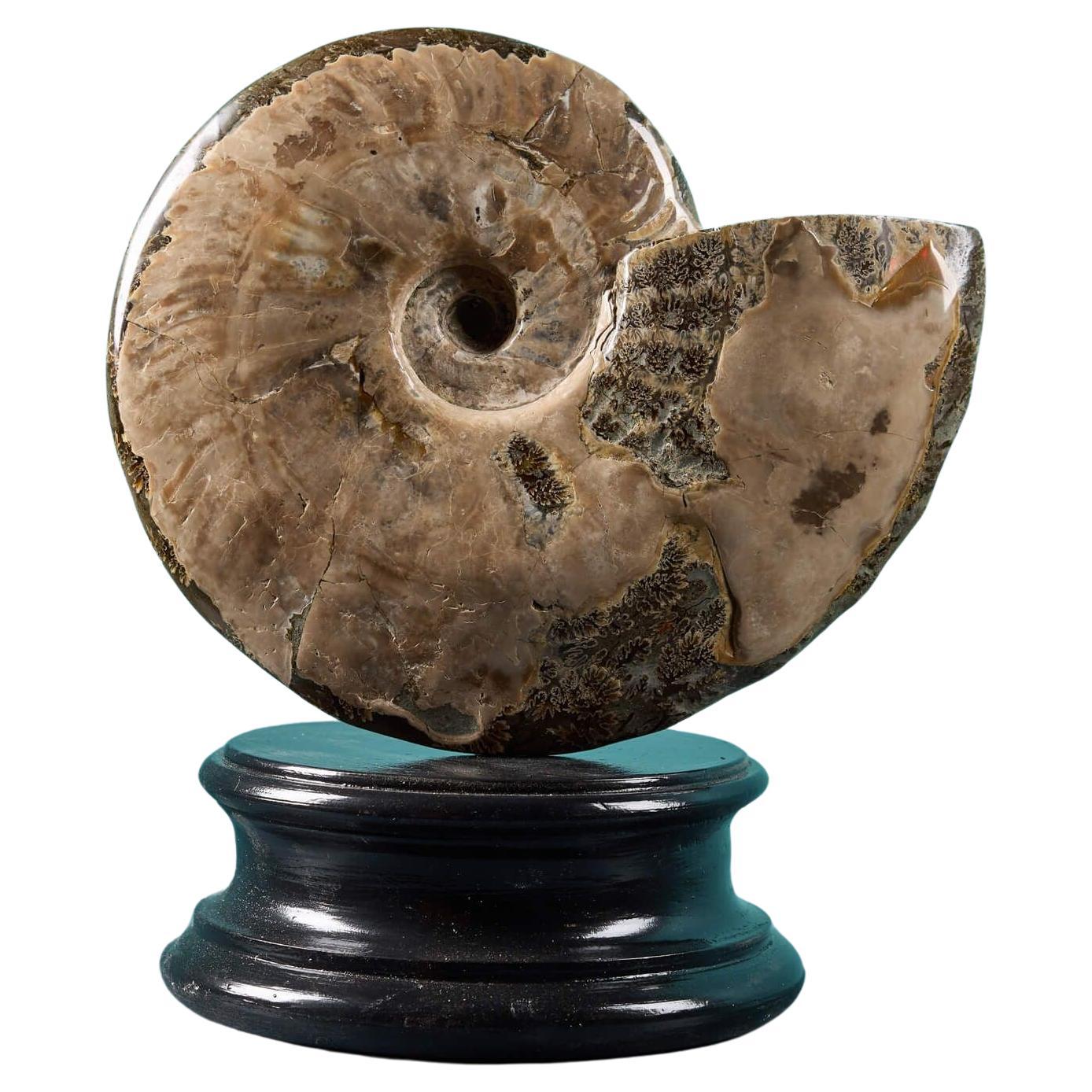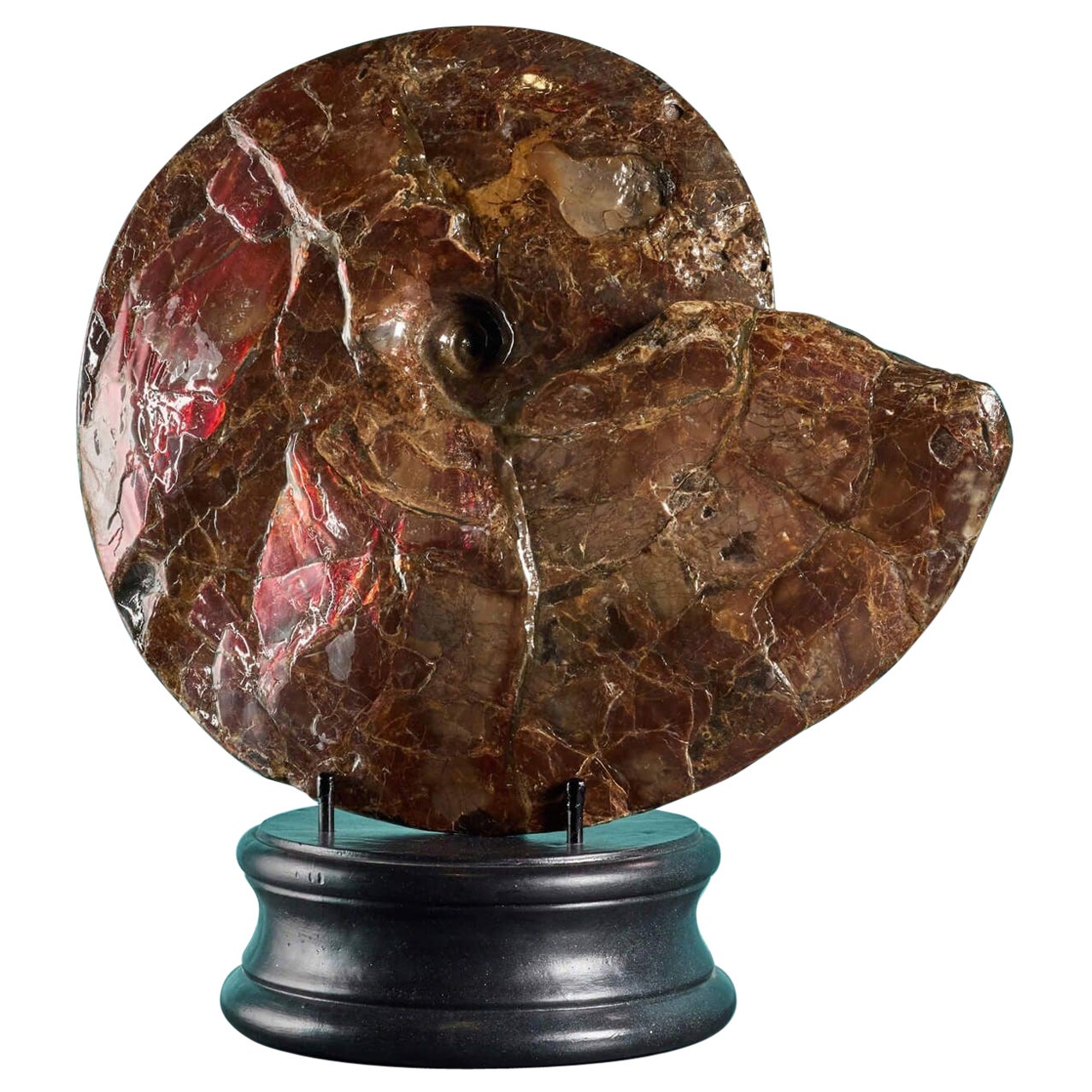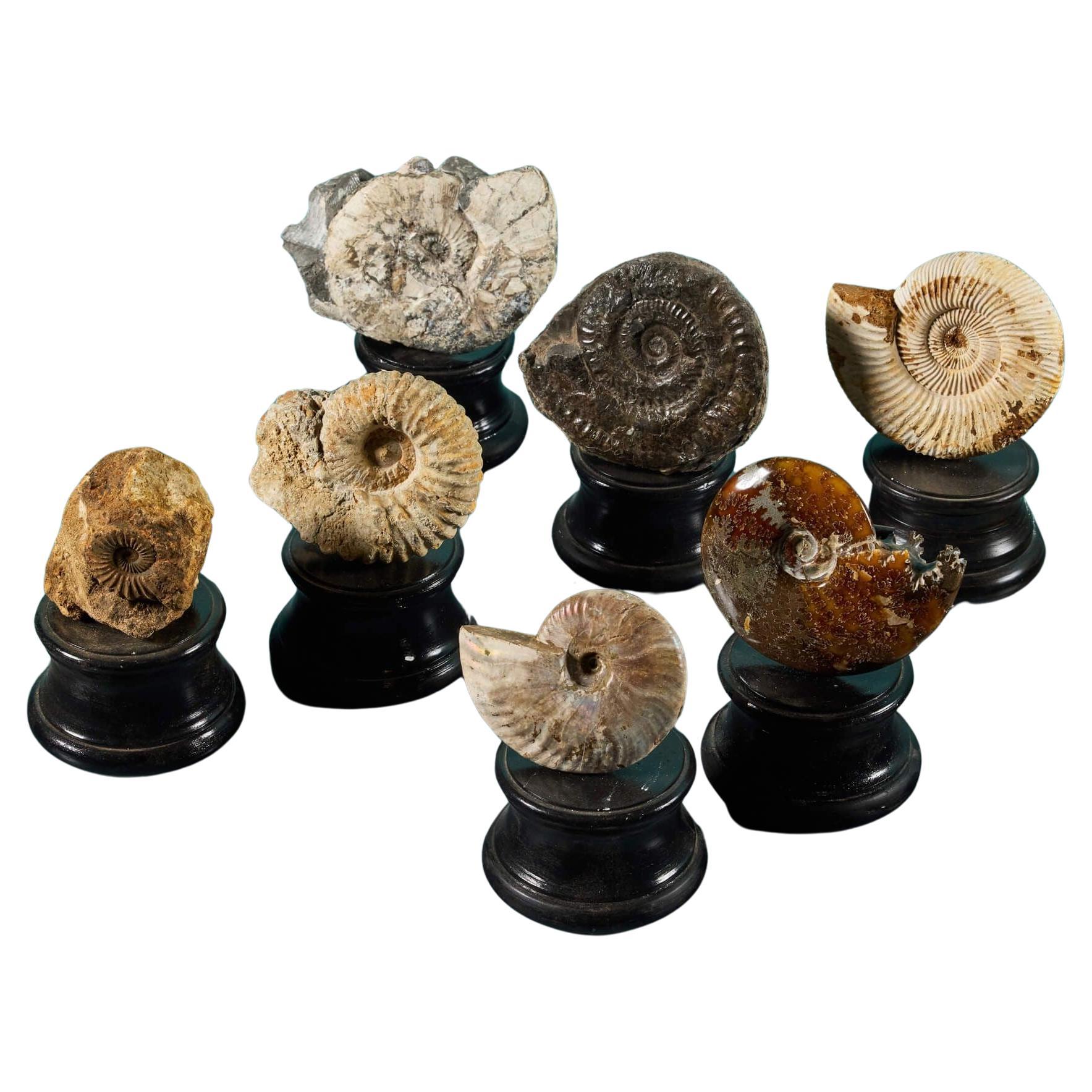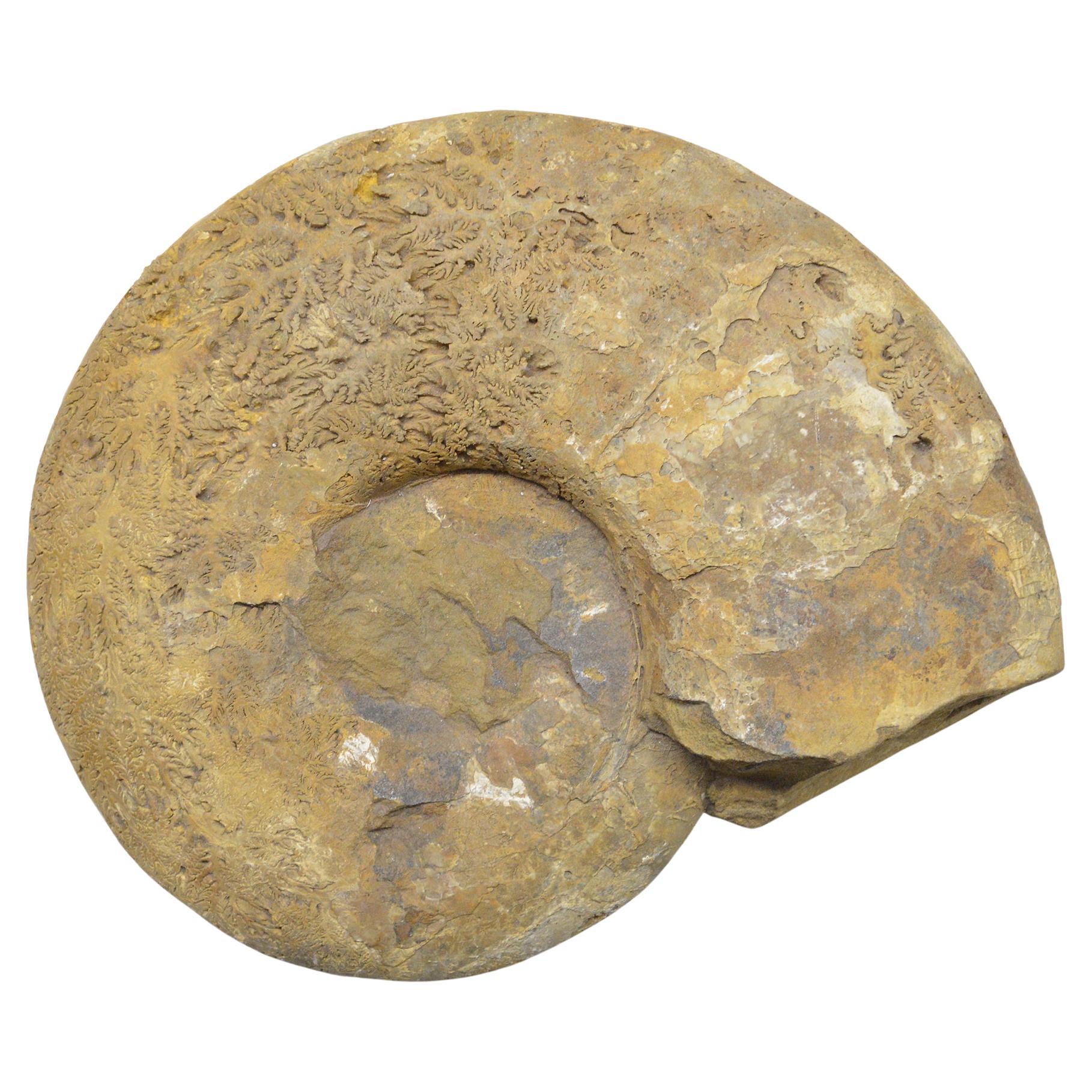Want more images or videos?
Request additional images or videos from the seller
1 of 10
Iridescent Ammonite Fossil
About the Item
Large spectacular iridescent ammonite fossil.
75 Million y/o
A magnificent example of one of the most spectacular fossils. A large and intensely vibrant ammonite, Placenticeras costatum, from the Bearpaw formation, Alberta, Canada, dating to the late Cretaceous period, around 75 million years before present. The surface of this long extinct marine creature has transformed over millennia into a dazzling, iridescent gemstone, its colours shifting in the light from vivid reds to emerald greens, to flickers of orange and gold, purples and brilliant blues. This effect is a natural result of the fossilisation process, a unique phenomenon only found on ammonites recovered from this location.
The ammonite, an extinct branch of the mollusc family, related to the modern octopus, takes its name from an ancient belief, recorded by Pliny the Elder, that their fossilised remains were in fact the horns of the ram-horned Egyptian god Ammon, which would bring good fortune to the owner. Most fossils of this kind are heavily restored or pastiches, and their colour is often artificially enhanced with varnishes. This example is completely preserved, with its unrestored original surface - a superb piece of natural history.
Most fossils of this kind are heavily restored or pastiches and their colour is artificially enhanced with varnishes. This is a completely preserved, natural piece with original surface. Mounted on a bespoke bronze base.
Measures : Diameter: 42 cm.
Height with stand: 47 cm
Provenance:
Discovered in the Blood Reserve, Alberta, Canada.
- Dimensions:Height: 16.54 in (42 cm)Diameter: 16.54 in (42 cm)
- Materials and Techniques:
- Place of Origin:
- Period:
- Date of Manufacture:circa 75 Million y/o
- Condition:
- Seller Location:London, GB
- Reference Number:
About the Seller
5.0
Recognized Seller
These prestigious sellers are industry leaders and represent the highest echelon for item quality and design.
Established in 2008
1stDibs seller since 2014
100 sales on 1stDibs
Typical response time: 8 hours
Associations
LAPADA - The Association of Arts & Antiques DealersInternational Confederation of Art and Antique Dealers' AssociationsThe British Antique Dealers' Association
- ShippingRetrieving quote...Ships From: London, United Kingdom
- Return PolicyA return for this item may be initiated within 14 days of delivery.
More From This SellerView All
- Petrified Incense Cedar Wood FossilLocated in London, GBThis spectacular cross section of petrified cedar wood comes from Saddle Mountain, Washington. It is remarkably large with a wonderful and highly aesthetic shape, exhibiting vibrant ...Category
Antique 15th Century and Earlier Natural Specimens
MaterialsPetrified Wood
- Tyrannosaurus Rex Tooth in Fossil MatrixLocated in London, GBTyrannosaurus Rex Tooth in Fossil Matrix. Late Cretaceous, circa 65 Million years before present. Lance Formation, Marchant Ranch Quarry, Niobrara County, Wy...Category
Antique 15th Century and Earlier Natural Specimens
MaterialsOther
- Large Leaf Fossil from the Green River FormationLocated in London, GBA large and beautifully preserved fossilised leaf from the Green River formation, a site which has brought forth some of the best-preserved fossi...Category
Antique 15th Century and Earlier North American Wall-mounted Sculptures
MaterialsOther
- Extraterrestrial Iron Meteorite SphereLocated in London, GBAletai Meteorite Sphere Iron - IIIE circa 4.5 Billion years old A perfect metallic sphere, extracted from the core of the famous Aletai Meteorite, di...Category
Antique 15th Century and Earlier Chinese Natural Specimens
MaterialsOther
- Natural Gogotte FormationLocated in London, GB'Louis XIV' Gogotte Formation Measures: circa 30 Million y/o 105 x 76 x 15 cm A magnificent example of a gogotte formation, nicknamed Louis XIV, composed of thick swirls and folds of sparkling sandstone. Discovered in the Oligocene sand dunes of Fontainebleau, France, formed circa 30 million years before present or later. The incredible, almost otherworldly appearance of gogottes may easily be mistaken for the work of a most talented artist. In fact, these sandstone sculptures are entirely natural in origin. They have been found in multiple locations but those from Fontainebleau, such as the present example, are the most remarkable. Thirty-five million years ago, a sea covered what is now the forest of Fontainebleau, and dunes of exceptionally fine and homogenous sand formed. As silica-rich water filtered through this sand, it turned into stone. The flow of water finely modelled the sandstone into the forms we now know as gogottes. These are rare and are only found sporadically, several metres buried underground. They owe their sparkling white appearance to the extreme and unmatched purity of the Fontainebleau sand, sometimes reaching a composition of 99.9% silica. Each of them is unique – a masterpiece slowly fashioned by the hands of Nature. The name “gogotte” was coined by French geologist Claude Guillemin (1923- 1994), inspired by the children’s book series Babar the Elephant...Category
Antique 15th Century and Earlier French Natural Specimens
MaterialsSandstone
- Ancient Egyptian Monumental Temple SphinxesLocated in London, GBA pair of monumental limestone sphinxes of Pharaoh Nectanebo I, from the processional avenue of the Serapeum of Memphis, 30th Dynasty, circa 379 - 360 BC. The sphinxes of the Serapeum have captivated travellers since Roman times. However, despite their significance, they are conspicuously absent from the collections of most major museums. Indeed, their existence in private hands is so improbable, and their imitations so numerous, that the present sphinxes were assumed to be modern copies throughout their recent ownership history. Finally recognised and conserved after an extraordinary chance discovery at a garden furniture sale...Category
Antique 15th Century and Earlier Egyptian Egyptian Figurative Sculptures
MaterialsLimestone
You May Also Like
- Opalised Iridescent Ammonite FossilLocated in Wormelow, HerefordshireA complete prehistoric Cleoniceras opalised iridescent ammonite fossil, originating from Madagascar, presented on an exclusive museum-quality painted plaster base. Over 200 million y...Category
Antique 15th Century and Earlier Malagasy Natural Specimens
MaterialsShell
- Large Red Iridescent Ammonite FossilLocated in Wormelow, HerefordshireA large red iridescent ammonite fossil dating from the late cretaceous period (100.5 – 66 million years ago). This huge plancenticeras ammonite is approximately 16 inches tall and has an iridescent lustre that showcases a vibrant red hue. Once a living creature, this ammonite has developed its red iridescent lustre over millions of years of compression, transforming into a striking gemstone. A rare find. Provenance: From the fascinating collection of Gordon Walkden (1944-2022), emeritus Professor of Geology at Aberdeen University. Affectionally known as Aberdeen’s answer to Indiana Jones, Walkden contributed enormously to research through his papers and talks on British marbles, minerals and fossils...Category
Antique 15th Century and Earlier Natural Specimens
MaterialsStone
- Fossil Agate Coral with Iridescent AmmonitesBy InteriLocated in Dublin, DalkeyFossil agate coral adorned with iridescent fossil ammonites. The grey piece of fossil agate coral is cut and polished and adorned with the iridescent...Category
Antique 15th Century and Earlier American Organic Modern Natural Specimens
MaterialsAgate, Coral
- Collection of 7 Ammonite FossilsLocated in Wormelow, HerefordshireA superb set of 7 ancient prehistoric ammonite fossils presented on our small turned painted plaster bases. This group showcases ammonites of varyi...Category
Antique 15th Century and Earlier Natural Specimens
MaterialsStone
- Large Fossil Stone AmmoniteLocated in Alessandria, PiemonteO/6416 - Large fossil stone shell - Ammonites were predatory Prehistorie cephalopod mollusks which existed between 400 and 66 million years ago before dying out during the exinction ...Category
Antique 15th Century and Earlier Malagasy International Style Natural Sp...
MaterialsStone
- Polished Jigsaw Ammonite FossilLocated in Wormelow, HerefordshireA complete prehistoric polished jigsaw ammonite fossil, originating from Madagascar, presented on an exclusive museum-quality painted plaster base. A natural historical artefact, pre...Category
Antique 15th Century and Earlier Malagasy Natural Specimens
MaterialsPrecious Stone
Recently Viewed
View AllMore Ways To Browse
Antique Spectacular
Iridescent Furniture
Furniture With Iridescent
Spectacular Light
Canada Only
Natural Vivid Emerald
Iridescent Light
God Stone
Heavy Gemstone
Iridescent Purple
Antique Shifter
Record Stand
Canadian History
Large Stone Sculpture Gold
Intension Bronze
Gemstone Specimen
Octopus Furniture
Horn On Stand





